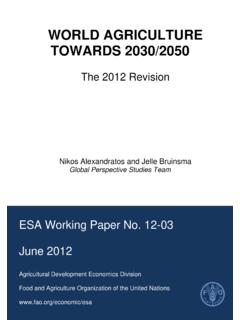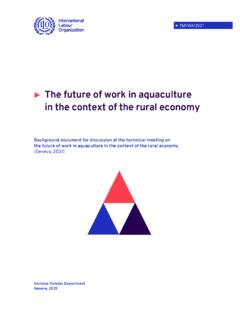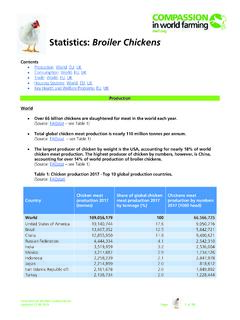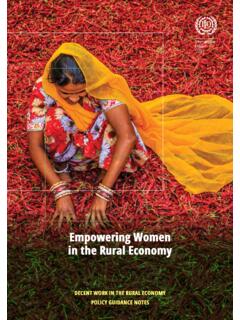Transcription of Part 1, chapter 2. Agriculture in Sub-Saharan Africa ...
1 OECD-FAO agricultural outlook 2016-2025. OECD/FAO 2016. PART I. chapter 2. Agriculture in Sub-Saharan Africa : Prospects and challenges for the next decade This chapter reviews the prospects and challenges facing the agricultural sector in Sub-Saharan Africa over the next decade. It reviews sector performance, outlines the current market context, provides detailed quantitative medium term projections for the ten-year period 2016-25, and assesses key risks and uncertainties. The outlook for Agriculture in Sub-Saharan Africa is situated in the context of several mega-trends that shape the sector's development.
2 These include rapid population growth, urbanisation and rural diversification, an associated structural transformation from farm to non-farm employment, a growing middle class, and increasing interest (both domestically and globally) in the continent's farmland. The outlook for Agriculture is broadly positive, but could be further enhanced by consistent policies and strategic investments, in particular in rural infrastructure. The statistical data for Israel are supplied by and under the responsibility of the relevant Israeli authorities.
3 The use of such data by the OECD is without prejudice to the status of the Golan Heights, East Jerusalem and Israeli settlements in the West Bank under the terms of international law. The position of the United Nations on the question of Jerusalem is contained in General Assembly Resolution 181(II) of 29 November 1947, and subsequent resolutions of the General Assembly and the Security Council concerning this question. 59. 2. Agriculture IN Sub-Saharan Africa : PROSPECTS AND CHALLENGES FOR THE NEXT DECADE.
4 Introduction The Sub-Saharan Africa1 (SSA) region accounts for more than 950 million people, approximately 13% of the global population. By 2050, this share is projected to increase to almost 22% or billion. Undernourishment has been a long-standing challenge, with uneven progress across the region. Despite being reduced from 33% in 1990-92 to 23%. in 2014-16, the percentage of undernourishment remains the highest among developing regions (FAO, IFAD and WFP, 2015). Owing to rapid population growth of over the same period, the absolute number of undernourished people has increased by 44 million to reach 218 million.
5 Slow progress towards food security has been attributed to low productivity of agricultural resources, high population growth rates, political instability and civil strife. However, vast regional differences remain and the success achieved in countries with stable political conditions, economic growth and expanding agricultural sectors suggests that appropriate governance systems, institutional capacities, and macro- economic, structural and sectoral policies can work together to improve food security on a long-lasting and sustainable basis.
6 The important role of the agricultural sector in contributing to food security is reflected in its prioritisation in the development agenda. The Comprehensive African agricultural Development Programme (CAADP) is an integral part of the New Partnership for Africa 's Development (NEPAD) and the sector's prominence in the region is evident in its contribution to total GDP, which is generally high in the global context. The high contribution of the agricultural sector to GDP also underlines the limited diversification of most African economies.
7 On average, Agriculture contributes 15% of total GDP, however it ranges from below 3% in Botswana and South Africa to more than 50% in Chad (Figure ), implying a diverse range of economic structures. Agriculture employs more than half of the total labour force (IMF, 2012) and within the rural population, provides a livelihood for multitudes of small-scale producers. Smallholder farms constitute approximately 80% of all farms in SSA and employ about 175 million people directly (Alliance for a Green Revolution in Africa , 2014).
8 In many of the countries, women comprise at least half of the labour force (FAO, 2015). Given its role in confronting the challenge of eradicating hunger and improving food security, this chapter considers the historic performance and current state of Agriculture in SSA, within the context of the region's political and economic conditions, natural resource situation and demographic structure. It acknowledges the role of policies and megatrends2. in shaping development of the agricultural sector. Megatrends include demographic change, the rise of the African middle class, growing access to new information and communication technologies, rapid urbanisation and consequent shifts in food demand.
9 This is accompanied by downstream modernisation of food systems, a considerable shift in the labour force from farming to nonfarm jobs, and rising global interest in available African farmland strengthened by the sharp rise in agricultural commodity prices over the past decade. 60 OECD-FAO agricultural outlook 2016-2025 OECD/FAO 2016. 2. Agriculture IN Sub-Saharan Africa : PROSPECTS AND CHALLENGES FOR THE NEXT DECADE. Figure Agriculture as a share of total GDP in 2014. %. 60. 50. 40. 30. 20. 10. 0.
10 Botswana India South Africa Nigeria Sudan Kenya Ethiopia Brazil Mali DRC. United States Canada European Union Australia Chile Mexico Russia Argentina China Angola Zimbabwe Zambia Ghana Mozambique Uganda Tanzania Chad Malawi Rest of the World Sub-Saharan Africa Note: DRC refers to Democratic Republic of the Congo. Source: World Bank (2016). 1 2 These megatrends are not inevitable and remain subject to a degree of uncertainty as well as future policies. The focus on SSA as a whole risks perpetuating a view of Africa as a single entity, however this chapter aims to provide an agricultural outlook , with a wider consideration of links to growth and food security, that reflects the complexity within the region.
















